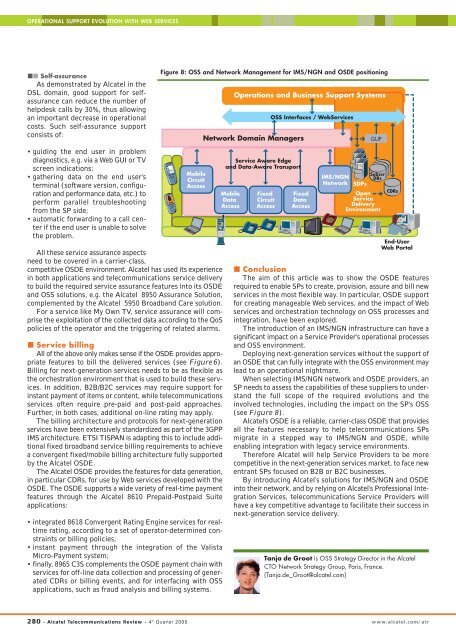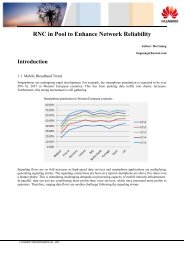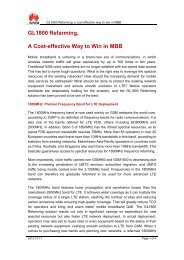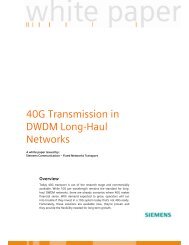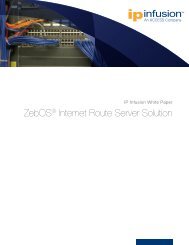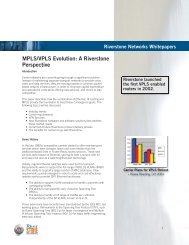report - Light Reading
report - Light Reading
report - Light Reading
You also want an ePaper? Increase the reach of your titles
YUMPU automatically turns print PDFs into web optimized ePapers that Google loves.
OPERATIONAL SUPPORT EVOLUTION WITH WEB SERVICES<br />
Self-assurance<br />
As demonstrated by Alcatel in the<br />
DSL domain, good support for selfassurance<br />
can reduce the number of<br />
helpdesk calls by 30%, thus allowing<br />
an important decrease in operational<br />
costs. Such self-assurance support<br />
consists of:<br />
• guiding the end user in problem<br />
diagnostics, e.g. via a Web GUI or TV<br />
screen indications;<br />
• gathering data on the end user’s<br />
terminal (software version, configuration<br />
and performance data, etc.) to<br />
perform parallel troubleshooting<br />
from the SP side;<br />
• automatic forwarding to a call center<br />
if the end user is unable to solve<br />
the problem.<br />
All these service assurance aspects<br />
need to be covered in a carrier-class,<br />
competitive OSDE environment. Alcatel has used its experience<br />
in both applications and telecommunications service delivery<br />
to build the required service assurance features into its OSDE<br />
and OSS solutions, e.g. the Alcatel 8950 Assurance Solution,<br />
complemented by the Alcatel 5950 Broadband Care solution.<br />
For a service like My Own TV, service assurance will comprise<br />
the exploitation of the collected data according to the QoS<br />
policies of the operator and the triggering of related alarms.<br />
Service billing<br />
All of the above only makes sense if the OSDE provides appropriate<br />
features to bill the delivered services (see Figure 6).<br />
Billing for next-generation services needs to be as flexible as<br />
the orchestration environment that is used to build these services.<br />
In addition, B2B/B2C services may require support for<br />
instant payment of items or content, while telecommunications<br />
services often require pre-paid and post-paid approaches.<br />
Further, in both cases, additional on-line rating may apply.<br />
The billing architecture and protocols for next-generation<br />
services have been extensively standardized as part of the 3GPP<br />
IMS architecture. ETSI TISPAN is adapting this to include additional<br />
fixed broadband service billing requirements to achieve<br />
a convergent fixed/mobile billing architecture fully supported<br />
by the Alcatel OSDE.<br />
The Alcatel OSDE provides the features for data generation,<br />
in particular CDRs, for use by Web services developed with the<br />
OSDE. The OSDE supports a wide variety of real-time payment<br />
features through the Alcatel 8610 Prepaid-Postpaid Suite<br />
applications:<br />
• integrated 8618 Convergent Rating Engine services for realtime<br />
rating, according to a set of operator-determined constraints<br />
or billing policies;<br />
• instant payment through the integration of the Valista<br />
Micro-Payment system;<br />
• finally, 8965 C3S complements the OSDE payment chain with<br />
services for off-line data collection and processing of generated<br />
CDRs or billing events, and for interfacing with OSS<br />
applications, such as fraud analysis and billing systems.<br />
Figure 8: OSS and Network Management for IMS/NGN and OSDE positioning<br />
Mobile<br />
Circuit<br />
Access<br />
Operations and Business Support Systems<br />
Network Domain Managers<br />
Service Aware Edge<br />
and Data-Aware Transport<br />
Mobile<br />
Data<br />
Access<br />
Fixed<br />
Circuit<br />
Access<br />
OSS Interfaces / WebServices<br />
Fixed<br />
Data<br />
Access<br />
IMS/NGN<br />
Network<br />
Conclusion<br />
The aim of this article was to show the OSDE features<br />
required to enable SPs to create, provision, assure and bill new<br />
services in the most flexible way. In particular, OSDE support<br />
for creating manageable Web services, and the impact of Web<br />
services and orchestration technology on OSS processes and<br />
integration, have been explored.<br />
The introduction of an IMS/NGN infrastructure can have a<br />
significant impact on a Service Provider’s operational processes<br />
and OSS environment.<br />
Deploying next-generation services without the support of<br />
an OSDE that can fully integrate with the OSS environment may<br />
lead to an operational nightmare.<br />
When selecting IMS/NGN network and OSDE providers, an<br />
SP needs to assess the capabilities of these suppliers to understand<br />
the full scope of the required evolutions and the<br />
involved technologies, including the impact on the SP’s OSS<br />
(see Figure 8).<br />
Alcatel’s OSDE is a reliable, carrier-class OSDE that provides<br />
all the features necessary to help telecommunications SPs<br />
migrate in a stepped way to IMS/NGN and OSDE, while<br />
enabling integration with legacy service environments.<br />
Therefore Alcatel will help Service Providers to be more<br />
competitive in the next-generation services market, to face new<br />
entrant SPs focused on B2B or B2C businesses.<br />
By introducing Alcatel’s solutions for IMS/NGN and OSDE<br />
into their network, and by relying on Alcatel’s Professional Integration<br />
Services, telecommunications Service Providers will<br />
have a key competitive advantage to facilitate their success in<br />
next-generation service delivery.<br />
280 - Alcatel Telecommunications Review - 4 th Quarter 2005 www.alcatel.com/atr<br />
SDPs<br />
GUP<br />
Subscr<br />
DBs<br />
Open<br />
Service<br />
Delivery<br />
Environment<br />
CDRs<br />
End-User<br />
Web Portal<br />
Tanja de Groot is OSS Strategy Director in the Alcatel<br />
CTO Network Strategy Group, Paris, France.<br />
(Tanja.de_Groot@alcatel.com)


